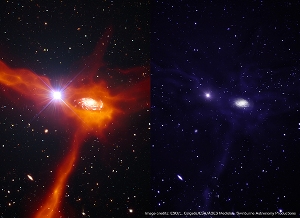Jul 16 2014
An international team of astronomers has discovered that gas around young galaxies is almost barren, devoid of the seeds from which new stars are thought to form—molecules of hydrogen.
 Artist’s impression of the gas surrounding a young galaxy in the distant universe. The gas, shown as red streams on the left, is actually invisible, and the starlight from the galaxy is too faint for astronomers to see directly. Instead, the gas is seen in silhouette against a bright, background quasar. Molecules in the gas imprint a shadow, or absorption line, onto the quasar light at a very specific color, as seen on the right, and astronomers can detect this shadow. Image credits: ESO/L. Calçada/ESA/AOES Medialab, Swinburne Astronomy Productions
Artist’s impression of the gas surrounding a young galaxy in the distant universe. The gas, shown as red streams on the left, is actually invisible, and the starlight from the galaxy is too faint for astronomers to see directly. Instead, the gas is seen in silhouette against a bright, background quasar. Molecules in the gas imprint a shadow, or absorption line, onto the quasar light at a very specific color, as seen on the right, and astronomers can detect this shadow. Image credits: ESO/L. Calçada/ESA/AOES Medialab, Swinburne Astronomy Productions
Without starlight to see them directly, the team, which includes Dr. Regina Jorgenson of the Institute for Astronomy at the University of Hawaiʻi at Mānoa—observed the young galaxies’ outskirts in silhouette.
They searched for telltale signs of hydrogen molecules absorbing the light from background objects called quasars—supermassive black holes sucking in surrounding material—that glow very brightly.
“Previous experiments led us to expect molecules in about 10 of the 90 young galaxies we observed, but we found just one case,” said Associate Professor Michael Murphy from Swinburne University of Technology in Australia. He co-led the study with Jorgenson.
Astronomers believe that stars begin to form in cold gas that is rich in molecules. The team observed galaxies at a time when the Universe was most actively forming stars, about 12 billion years ago.
“This is a little mystery. This is when most stars are born, and we think this gas forms stars eventually, but it lacks the key ingredient—molecules—to do so,” Murphy said.
The team believes that location and time are the key.
“The gas we observe in silhouette probably lies too far from the galaxies to form stars,” Jorgenson said.
“It’s got lots of potential, but it hasn’t had time to fall into the richer, denser parts of the galaxies which might be better stellar nurseries.”
The researchers made new observations of more than 50 quasars for this study using the 6.5-meter Magellan telescopes in Chile.
The study will be published in the Monthly Notices of the Royal Astronomical Society and is available online at http://arxiv.org/abs/1407.1111.
It was conducted by researchers from the University of Hawaiʻi at Mānoa, Swinburne University of Technology, the University of Cambridge and the University of Arizona.
Founded in 1967, the Institute for Astronomy at the University of Hawaii at Mānoa conducts research into galaxies, cosmology, stars, planets, and the sun. Its faculty and staff are also involved in astronomy education, deep space missions, and in the development and management of the observatories on Haleakala and Maunakea. The Institute operates facilities on the islands of Oʻahu, Maui, and Hawaiʻi.
For more information, visit: http://www.ifa.hawaii.edu/info/press-releases/HydrogenMolecules